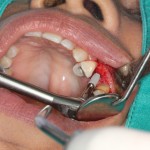
While flapless placement of dental implants is considered to have advantages over flap based procedures there are potential disadvantages in the ability to visualise anatomic structures, contour bone and readily irrigate to prevent osseous damage. The aim of this study was to compare the placement of flapped vs. flapless dental implants utilizing clinical, radiographic, microbiological, and immunological parameters.
Twenty patients aged ≥ 18 requiring implants were randomised to flapless (test) or regular flap (control) placement of implants. Both groups of 10 patients received 15 implants. Patients were followed up at 1, 2, 6, and 12 week and clinical recordings, sulcular fluid sampling, microbiological analysis, and digital subtraction radiography used to assess surgical outcome. A questionnaire was administered at 7 days to assess pain experience.
They found that in the control group:-
- There was statistically significantly more pain the in first two days post-operatively. (P < 0.001).
- Peri-implant sulcus depth was significantly greater at both 6 and 12 post-surgical weeks (P < 0.001).
- Crestal bone loss of 0.29 ± 0.06 mm, whereas no bone resorption was detected in test group.
They concluded that
Flapless implant placement yielded improved clinical, radiographic, and immunological outcomes compared with flapped implantation. In addition, patients seem to better withstand flapless implant placement.
This study was partly supported by Colgate-Palmolive Hellas.
Comment
We recently considered a systematic review (Dental Elf 2oth Aug) that looked specifically at flapless placement in the posterior maxilla this suggested that the flapless approach was a viable approach. This is a small study and it did not provide the location of the implants. The sample size (10 per group) was based on a power calculation looking to identify a difference of 0.8mm between the two groups.
Links
Tsoukaki M, Kalpidis CD, Sakellari D, Tsalikis L, Mikrogiorgis G, Konstantinidis A. Clinical, radiographic, microbiological, and immunological outcomes of flapped vs. flapless dental implants: a prospective randomized controlled clinical trial. Clin Oral Implants Res. 2012 Jun 18. doi: 10.1111/j.1600-0501.2012.02503.x. [Epub ahead of print] PubMed PMID: 22708917.

Interesting study. However 3 months is extremely short-term.
I did not have any doubt that flapless provides better results on the PRO. However, I think there is a higher risk to have esthetic complications with flapless procedure (you don’t realize you are too close to the buccal plate).
Also inclusion criteria were very strict:
Bone width >6 mm, bone architecture without undercuts, and at least 5 mm width of keratinized tis- sues were also required. A slam dunk, definitely not the “typical” patient.
Statistical part is also a bit questionable: they run a lot of comparisons, wouldn’t that affect type I error.